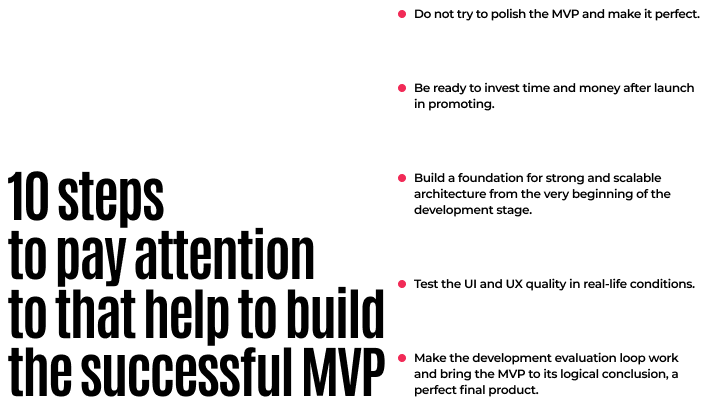Recent years have shown us that if business owners wish to avoid struggling to survive but to instead grow, they need to move their services into the digital sphere. The most common way to start is to build your own start up, but how do we avoid failing along with losing all of the invested funds too? The answer lies in finding a comprehensive description of what is an MVP, and how to build it without fear of failure, in our article.
Why the startup founders develop the MVP?
The Minimum Viable Product (MVP) is an early version of a product that should be developed in later phases. It includes the core features of the product and basically, it is needed to collect the feedback for further analysis, test theories, and prove serviceability.

Evaluation of the target market
As far as any business launch is concerned this comes with various risks for any business, the MVP allows to lessen these risks as much as possible. According to the researchers who evaluate the causes for startup failure, most agree that the most common is the absence of product need within the intended market. That means that the evaluation of the customer’s needs was performed poorly or not performed at all. As a result, if a business launches a long-developed and massive product they risk failing badly at this point. That is why startup founders begin with smaller launches of MVPs that can prove or disprove the theories.
Test the set of features to be added to the final product
Together with the market requirements, MVP helps to check whether all intended features of the product fits the needs of the customers. Eventually the businesses create products for users, and not to simply build the product. After the MVP launch comes the time to gather all feedback, perform its evaluation, and bring consecutive implementations of the tasks given by the target audience.
Saving time to come to the market
Ultimately, one of the most crucial steps for any startup point is time taken. The development period cannot last for too long, otherwise the business can lose pace and probably its place in the market niche. If the time taken to develop a product is too long it may see other businesses reap all of the benefits with their own MVPs. Although the MVP does not serve as the polished final product, these rivals are already in the market and can expand their customer base. If the product is an essential product and brings value, people would probably hang on a while longer and join the ready-made startup with enthusiasm.
Checking technical stability of the product
The success of any digital product greatly depends on its technical issues and serviceability. The MVP can highlight any weak points of architecture, non-optimized coding, and simple bugs appearing under load. The users can excuse some technical issues to the MVP, which could void the final product. Nevertheless, even the MVP should be as polished and economical as possible before launch. Inability to introduce sufficient quality of the code could be seen as a highly neglectful and potentially costly mistake by the development team.
Proving the user experience proper designing
Besides the code, the developers team also creates the interface of the product. The interface is the first thing a user sees, this usually has a great influence on the user’s overall experience (UX) and desire to work with this product in the future. So, this MVP phase allows the possibility to test the code and the user interface (UI) together.
Attracting additional funding to the product
Without the MVP phase, the business owner risks losing additional external funding. With the MVP it is possible to show a live product that can perform activities and tasks. This would adequately demonstrate to potential investors why funding of the project would make good business sense. Much harder is to offer presentations and employ the use simple graphics while trying to prove the pitch.
Care about further scalability of the product
Launching the MVP is not the real ending for development and evolvement. Starting with the definition of the business model, the business should place the basis for the further scalability of the product. The combination of proper business logic and technical capability can ensure market stability and growth. Even the products that had a great launch period faced stagnation and further petrification when not developed elaborately.
The most common reasons MVPs fail
Concluding stated above, the most common reasons why the MVPs fail include:
– Inability to perform, or totally ignoring the market research and target audience requirements.
– Implementation of the wrong features of the product.
– Ignoring or misinterpreting the feedback from users.
– Inability to arrange the cooperation within the team.
– Not performing analysis of the feedback and user interactions.
– Non-timely appearance on the market with the product.
– Inability to be flexible and deal with the competition.
– Weak and non-flexible business model.
– Desire to perfect the product to the detriment of development time.
– Insufficient scalability of the product.
– Poor quality of the code or weak UI UX.
– Performing weakly or lacking promotional activities after launch.

The overall MVP launch procedure is similar to the loops sequence when a business owner performs analysis, builds the product, launches it, gathers feedback, and analyses it. In such a way, the loop circles and starts to repeat. Most of the failures appear when founders break this circle and leave the analysis-implementation process.
Any MVP can serve as the visual implementation of the business idea. It undergoes numerous tests to check the theories that serve as the basis for the product. In case the failure is imminent due to external or irresistible issues, it is better the MVP fails rather than the final product itself.
10 steps to pay attention to that help to build the successful MVP
So, how is it possible to build the MVP and not have it fail? Try following these recommendations and find that the MVP creation process is not as complicated as you may think especially when you have experienced developers.
1. Start with the evaluation and analysis phase. The intended market, as well as your intended users, need some personal considerations. Perform the preliminary interrogation, analyse any future competitors and their products.
2. Build a comprehensive plan. State what features should be built first and when to introduce. Which ones can be held back for later, leaving enough scope to scale up should be given consideration from the very outset of the development.
3. Calculate the possible payment methods and the platforms for future launch adjustments. That will help to define the business model flexible enough for your target market.
4. Be prepared to act on relevant feedback from real users who will try the product. Never ignore the negative feedback, as sometimes it can reveal hidden problems that have been overlooked. Better the bitter pill now than later.
5. Analyse the feedback and think how to possibly implement the requested features in the product. Very often it is better to do nothing than to introduce requested changes, therefore the analysis stands as the first step of this recommendation.
6. Do not try to polish the MVP and make it perfect. Plan the approximate date of the launch, check the worldwide events that can influence the success of the launch, and act. A timely start can be more benificial than the pursuit for perfection.
7. Be ready to invest time and money after launch in promoting. If people are unaware of the product they will not leave the feedback a business needs to perfect the product. Remember that your competitors mostly do the same things when promoting their products, make yours stand out from the crowd, and highlight any imaginative features.
8. Build a foundation for strong and scalable architecture from the very beginning of the development stage. Though the code should not be perfect, test it to avoid critical crashes that make the use of the product impossible. Some bugs are almost inevitable, and the MVP is the right place to reveal and fix them.
9. Test the UI and UX quality in real-life conditions. For example, a business that may not have foreseen that your product could be used on mobile, so it was not prepared for it. User test and user behaviour evaluations can prove that the initial theory was deficient and it is prudent to introduce changes and avoid future losses.
10. Make the development evaluation loop work and bring the MVP to its logical conclusion, a perfect final product. Having experience on the MVP’s launch, makes it easier to launch any future product. In some cases, the MVP phase offers the possibility of finding the core of your target audience who will follow the ready product as well.


The same thing goes for investors who liked the MVP and wish to use the product. That is why they will most likely take the investment risk to make the product possible and successful. Though, it is sometimes better to rely on your own instincts and capabilities. Plan and track the market, gather the right team who will develop the product and ensure its stability. Build a unique and useful product that can inspire the world.
In case you need a team of experienced developers from a startup web development company to implement your project into life – contact us, and we will build something great together.


















